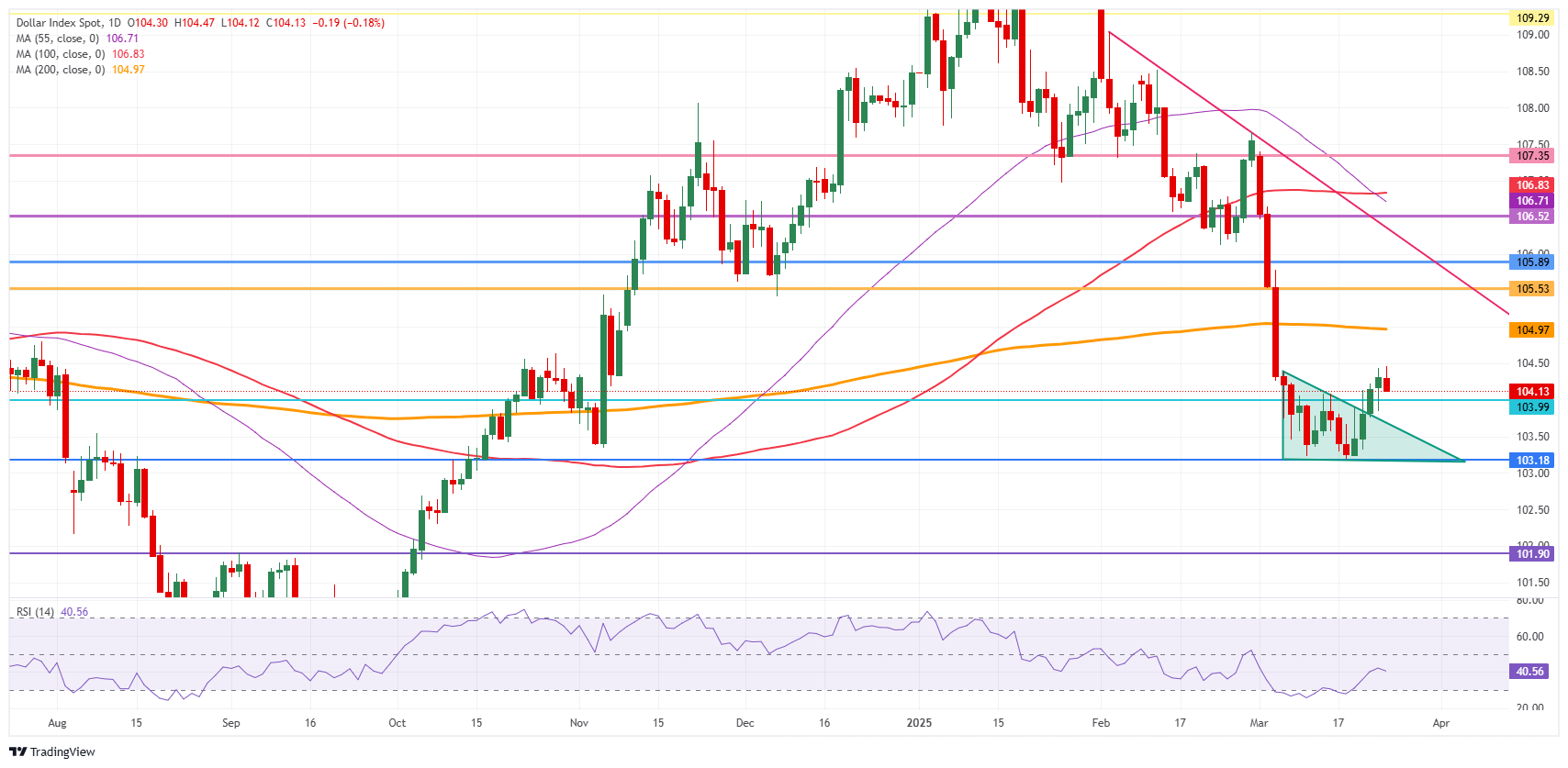US Dollar falls slightly amidst new tariffs and US officials’ comments on Europe
- Markets mull US Vice President JD Vance’s recent comments about Europe in a leaked Signal chat.
- US President Trump launches “secondary tariffs”.
- The US Dollar Index fails to break 104.50 after a brief test.
The US Dollar Index (DXY), which tracks the performance of the US Dollar (USD) against six major currencies, has failed to break above 104.50 on earlier attempts. The index trades slightly above 104.00 at the time of writing os Tuesday, while markets assess two main stories. The first market driver comes from United States (US) President Donald Trump, who issued “secondary tariffs” of 25% on all goods from countries that still buy Oil from Venezuela. Trump eased off on the size and broadness of reciprocal tariffs that are set to kick in on April 2 and commented about adding more targeted tariffs on cars, aluminum, pharmaceuticals, chips and lumber, Bloomberg reports.
Meanwhile, markets are looking for comments from the European bloc after a US news editor got invited by mistake to a Signal’s chat group with several Trump administration officials, including Vice President JD Vance, National Security Advisor Michael Waltz, Defense Secretary Pete Hegseth and Secretary of State Marco Rubio, among others. Comments from JD Vance towards Europe painted a clear picture of what and how he would like to see the EU being targeted with tariffs to pay for the US military actions against Houthi rebels, the Financial Times reports. The issue not only raises questions on the stance of the US towards Europe but also about security problems as a third-party chat application was used to discuss US military operations, weapon inventories and tactical plans.
Daily digest market movers: German data offsetting
- In early European trading, the German Institute for Economic Research (IFO) has released its Sentiment Index. The Current Assessment number came in at 85.7, beating the 85.5 expectation and the previous 85.0 reading.
- Around 12:40 GMT, Adriana D. Kugler of the Board of Governors of the Federal Reserve (Fed) is due to speak on the economic landscape and entrepreneurship at the US Hispanic Chamber of Commerce 2025 Legislative Summit.
- At 13:00 GMT, the Housing Price Index for January is due. Expectations are for a softer increase of 0.2% compared to the previous 0.4% reading.
- At 13:05 GMT, Fed Bank of New York President John Williams delivers opening remarks at the 2025 New York Fed Regional and Community Banking Conference at the New York Fed, New York.
- At 14:00 GMT, some US economic data will be released:
- The US Conference Board Consumer Confidence for March will be released. No forecast is available.
- New Home Sales are expected to climb to 0.68 million units in February compared to 0.657 million in January.
- The Richmond Fed Manufacturing Index is expected to climb to 8 in March, coming from 6 the previous month and signalling a pickup in activity.
- Equities are mixed this Tuesday, with Chinese indices slumping. The Hang Seng closed over 2% lower. European equities are ticking up over 0.50%, while US futures are down by less than 0.50% on the day.
- According to the CME Fedwatch Tool, the probability of interest rates remaining at the current range of 4.25%-4.50% in May’s meeting is 89.2%. For June, the odds for borrowing costs being lower stand at 62.5%.
- The US 10-year yield trades around 4.35% after bonds sold off on Monday with the surge in equities.
US Dollar Index Technical Analysis: Contradictions and correlations
The US Dollar Index (DXY) faces some selling pressure on Tuesday after a very early test to break above 104.50. The turnaround comes after US President Donald Trump issued more concerns and constraints on tariffs ahead of the deadline on April 2. The leaked messages from US Vice President JD Vance on Europe and other trade partners are an issue of concern for markets.
With the weekly close above 104.00 last week, a large sprint higher towards the 105.00 round level could still occur, with the 200-day Simple Moving Average (SMA) converging at that point and reinforcing this area as a strong resistance at 104.97. Once broken through that zone, a string of pivotal levels, such as 105.53 and 105.89, could limit the upward momentum.
On the downside, the 104.00 round level could be considered the first nearby support. If that does not hold, the DXY risks falling back into that March range between 104.00 and 103.00. Once the lower end at 103.00 gives way, watch out for 101.90 on the downside.

US Dollar Index: Daily Chart
US Dollar FAQs
The US Dollar (USD) is the official currency of the United States of America, and the ‘de facto’ currency of a significant number of other countries where it is found in circulation alongside local notes. It is the most heavily traded currency in the world, accounting for over 88% of all global foreign exchange turnover, or an average of $6.6 trillion in transactions per day, according to data from 2022. Following the second world war, the USD took over from the British Pound as the world’s reserve currency. For most of its history, the US Dollar was backed by Gold, until the Bretton Woods Agreement in 1971 when the Gold Standard went away.
The most important single factor impacting on the value of the US Dollar is monetary policy, which is shaped by the Federal Reserve (Fed). The Fed has two mandates: to achieve price stability (control inflation) and foster full employment. Its primary tool to achieve these two goals is by adjusting interest rates. When prices are rising too quickly and inflation is above the Fed’s 2% target, the Fed will raise rates, which helps the USD value. When inflation falls below 2% or the Unemployment Rate is too high, the Fed may lower interest rates, which weighs on the Greenback.
In extreme situations, the Federal Reserve can also print more Dollars and enact quantitative easing (QE). QE is the process by which the Fed substantially increases the flow of credit in a stuck financial system. It is a non-standard policy measure used when credit has dried up because banks will not lend to each other (out of the fear of counterparty default). It is a last resort when simply lowering interest rates is unlikely to achieve the necessary result. It was the Fed’s weapon of choice to combat the credit crunch that occurred during the Great Financial Crisis in 2008. It involves the Fed printing more Dollars and using them to buy US government bonds predominantly from financial institutions. QE usually leads to a weaker US Dollar.
Quantitative tightening (QT) is the reverse process whereby the Federal Reserve stops buying bonds from financial institutions and does not reinvest the principal from the bonds it holds maturing in new purchases. It is usually positive for the US Dollar.

